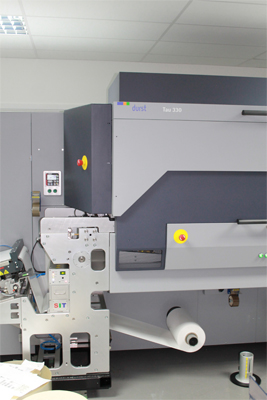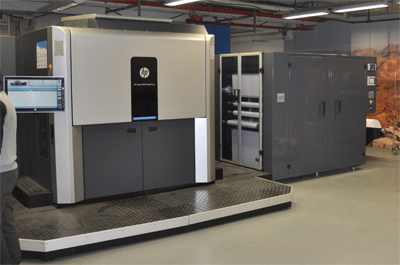Inline priming unit on HP Indigo 20000 flexible packaging press
Digital labels and packaging are growing strongly, but the day of the universal substrate, suitable for all print processes, is still some way off. There are steps that digital converters are taking to provide better quality and performance. Sean Smyth looks at the options.
The choice of a label or packaging substrate is important. It has to perform to the required physical specifications, of caliper, colour, strength, barrier and resistance, adhesion and opacity. It has to perform well in printing, in conversion, on the filling/labelling line as well as with the consumer. Trying to get a material that has the required end user properties and is suitable for several different printing processes is a major challenge, and there are several approaches being followed to improve this situation.
Different demands
There are many materials from unsupported films through to heavy corrugated boards that are in widespread use. These have been used with analogue printing (and drying) methods for many years and they generally perform well. As digital printing grows in importance, the performance of these substrates is being examined in new ways.
The mechanisms of digital print are very different to flexo, gravure or offset printing, and the demands on the surface of the substrate are different. HP Indigo presses for labels and packaging use the ‘one shot’ method, where the image separations are built up onto the printing blanket in perfect register, and transferred to the stock in one pass.
The result is a thin, offset-like film, with the capability of multiple whites, either at the base or top, and spot colours. The hot, tacky ink layer comes into contact with the substrate at a lower temperature causing the ink to solidify and stick to the substrate, so totally peeling off the blanket. There is a range of blanket-temperature operation window depending on the substrate, a slight drawback is limited degrees of adhesion in some cases as the ink does not penetrate the surface significantly. To get over these issues HP, recommends the use of a primer, and it includes priming units in the web-fed WS6600 and the new 20000, and the carton press 30000.
Primed and ready
Primed substrates are available, with Avery Dennison Label and Packaging Materials adding top coated materials, TC7214, to eliminate a step in the digital label printing.
‘Demand for digital is still growing strongly in almost all segments. Brand owners value the differentiation and customisation that is possible, as well as the ability to cope easily with proliferating SKUs,’ said Kunhao Wang, business development manager, digital products. ‘For label converters, the challenge is to maintain label quality and visual impact at a realistic cost. Removing the inhouse coating step gives major benefits, cutting production times and also reducing the risk of failed runs.’
The TC7214 Indigo Topcoat is designed to eliminate the risks and costs involved during inhouse priming. It has been calibrated specifically for Avery Dennison processes and products, giving optimum ink transfer and adhesion across a wide range of different segments and applications. The company now offers more than 130 HP certified products in its digital portfolio. Both HP certified PE85 and HGW facestocks are now available with the new topcoat, for home and personal care and food applications.
With the inline priming (ILP) unit, converters can run the same standard, non-treated media used in analogue production on HP Indigo equipment without offline substrate preparation. Michelman, a global developer of water-based barriers and coatings for flexible film packaging, paperboard and corrugated cartons supplies the priming solutions.
There is Sapphire for papers and Topaz for filmic stocks, and the company has released a new primer, Michem In-Line Primer 030 (ILP030), which is designed to broaden media compatibility from paper-based substrates to synthetic media, including textured papers, on the WS6000 series of presses. The ILP040 helps improve the print-receptive surface of synthetic substrates to aid the ink transfer and adhesion.
UPM Raflatac is an HP Indigo Preferred Media Partner, supplying dedicated HP Indigo products backed with full support. Most Raflatac label materials generally work well with UV inkjet and also provide good results on Xeikon presses without needing additional surface treatment.
 Cleaning and surface treatment on Durst Tau 330 before the splicing table
Cleaning and surface treatment on Durst Tau 330 before the splicing table
On the surface
Xeikon presses use powder toners with a heat and pressure fusing that bonds the toner into the surface of a range of substrates. No pre-treatments are required on self-adhesive and pressure sensitive labelstocks, including paper, PP, PET, vinyl and many co-extruded films. The new Ice toner needing lower temperature fusing has broadened the range of label stocks to include PE.
The Xeikon Aura Partner Network has several label and board suppliers offering standard and jumbo reels. There is a database of script files for common grades, allowing users to download colour profiles and optimal fuser settings.
In inkjet a different range of interactions takes place, depending on the nature of the ink. The non-impact process delivers very high numbers of small droplets onto the stock, and on top of wet ink and a high degree of control is needed. On paper there will be a degree of absorption and many materials are primed to achieve the best results.
There has been much work in preparing special surface coatings for the variety of inkjet ink systems to keep the colourant at the surface in papers, helping make inkjet suitable for more applications. The majority of higher productivity systems use UV curing inks and these are formulated to give excellent adhesion and flexibility on label stocks with stretchable and shrinkable grades available. Many of the high performance label presses are fitted with web cleaners and corona treatment systems to help printability and adhesion on a wide range of filmic substrates. These treat the surface and help render old stocks printable.
Growing market
The time between printing and curing is an important function for optimising inkjet quality by allowing a degree of flow out that promotes adhesion while controlling the tone value increase (dot gain for those of us of a certain vintage). Some systems provide LED interdeck pinning that fixes the ink prior to a final full cure.
This also eliminates potential coalescence effects where the droplets inter-mix and bleed into each other, that can result in a streaky mess at the extreme, or significant loss of detail if the effects are lower. There are lots of patents on the issue and press manufacturers have done a lot of work with ink and printhead makers to improve quality. Matching the ink, head and system with a particular stock is a necessary part of making inkjet work. The Epson SurePress L-4033 uses water-based pigmented ink that has good adhesion on a variety of substrates with no pre-treatment.
As the digital market matures more suppliers see volume growth and are developing substrates suitable for digital printing. The ideal for the converter is to be able to use any stock on any process, but this is impractical, and treating the surface is the way of improving printability to boost quality and performance. Paper, board, self-adhesive label stock and unsupported films (often multi-layer construction) have very different surface characteristics in structure, free energy and chemistry.
While analogue processes have had hundreds of years to tweak the inks and processes, digital has had a much shorter opportunity. So be prepared to work on the methods of handling substrates, and the reward is improved performance without having to pay large premiums for special materials over the analogue costs.






